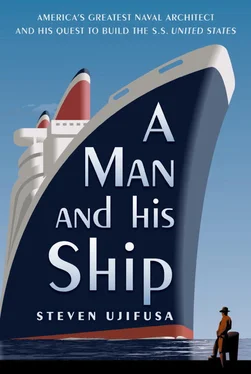But the German triumph did not deter Clement Griscom. Teaming up with financier J. P. Morgan, the Philadelphian hoped to buy every single transatlantic shipping line, European and American, and merge them into a gigantic shipping trust based in New York. The two men made a perfect team. Like Griscom, Morgan was from an old-line family that had been wealthy for generations. His huge physique reflected a gargantuan appetite for food, rare books, art, and mistresses. A hideous outbreak of rhinophyma left his nose bloated and purple, a condition that made him avoid photographers. But Morgan possessed a genius for deal making. The financial mastermind of the American industrial trusts, Morgan believed that consolidation was the future of American business. To him, investing in steamships was a good deal more interesting than steel, sugar, and oil—they awakened a lust in him equal to his passion for art and women. The transatlantic liner was the era’s ultimate status symbol, and Morgan vowed to own as many of them as he could. And to get his hands on them, he needed Griscom’s shipping savvy.
To break the European grip on the transatlantic trade, Griscom and Morgan would use the House of Morgan’s financial muscle to force all parties, American and foreign, into the trust. It would be called the International Mercantile Marine, a company that under another name would grow to become the largest and greatest American shipping firm, one that would be closely identified with the career of the young boy so awed by the christening of St. Louis.

2. ESCAPING THE RICH BOYS
After the launch of the great St. Louis in November 1894, the bookish, sickly William Francis Gibbs began thinking and reading of nothing but ships. Back at his father’s mansion on North Broad Street, his bedroom was cluttered with technical publications that he quietly read into the night. Most he had borrowed from his father’s study.
A reclusive, high-strung child, little Willy Gibbs was tongue-tied and unnerved by the parade of business and social callers to his parents’ home. Once when an engineer who worked for his father came by, he found the Gibbs boy engrossed in a periodical.
“What are you reading, Francis?” the engineer asked.
The boy silently handed over an issue of Cassier’s, a sophisticated engineering trade journal.
“Good Lord!” the visitor exclaimed.
William Francis snatched the issue back and resumed his reading. 1
Born on August 24, 1886, Willy grew up in the “let-the-poor-child-alone system of education,” a journalist wrote later, probably based on the child’s own adult recollections. His mother seemed to spoil him. “A sneeze was always good for a week at home. A slight cough was good for a month. A pronounced bark enabled him to stay away from school for an entire year.” 2He also forged a close bond with his younger brother, Frederic, born when William Francis Gibbs was still a twenty-month-old toddler. Both were fascinated not just with ships, but also firefighting equipment. They found a fellow enthusiast in the family’s coachman, a former Philadelphia fireman. If he heard about a fire somewhere in the city, he would rouse the boys from their sleep, hitch up the horses, and gallop with them into the dark corners of the industrial city. “Lumberyard fires are almost always terrific!” Gibbs later recalled. 3
His parents, on the other hand, were not interested in showing Little Willy the rougher side of Philadelphia. They made sure their six children—William Francis had four older sisters in addition to his younger brother—grew up in Gilded Age opulence. Father William Warren Gibbs was also an avid reader of engineering journals, but he scanned them looking for ideas to back. He was not an inventor, but a promoter, a wheeler-dealer who had a knack for associating with other men of wealth and ambition. With his cronies, the entrepreneurs Peter Widener and William Elkins, Gibbs shrewdly chose some “respectable” men to sit on the board of the United Gas Improvement Company, which by the 1890s had enriched many of Philadelphia’s oldest families and earned an infamous reputation for political corruption. 4He also possessed a smooth tongue and legendary powers of persuasion. The former provost of the University of Pennsylvania, the patrician Dr. William Pepper Jr., once tried to solicit a donation to his Ivy League institution from William Warren Gibbs. A fifty-thousand-dollar contribution would help Gibbs’s social standing, the distinguished physician hinted. But the middle school dropout deftly turned the tables on Pepper, convincing him to purchase stock in a new venture: Marsden Cellulose, which sold ground-up coconut shells to insulate battleships. 5The New York Times reported that the smelly material was “unhealthful and breeds vermin.” 6
Mother Frances used her husband’s vast wealth to throw lavish parties. At one of her fêtes, the ballroom of a Philadelphia hotel became a “magnificent apartment of the period of Louis XIV… enhanced by profuse decorations of palms, ferns, and American beauty roses.” 7To cap off a season at their summer home in Spring Lake on the New Jersey shore, the Gibbs family hosted a “bal poudre”—the guests wore powdered wigs and hair. 8When the Gibbs’s eldest daughter, Augusta May, married sportsman William Hamilton Tevis Huhn in 1899, a reporter marveled at the wedding gifts on display at the Gibbs home, noting that “one large room could not hold the great amount of cut glass, silver, in plate and in service, rare china, ornaments and bric-a-brac.” 9
But their efforts at social acceptance were in vain: Philadelphia snobbery held that the Gibbs family mansion on rich and opulent North Broad Street was on the wrong side of Market Street, the demarcation line separating “fashionable society” from the nouveaux riche.
For the Philadelphia elite, family pedigree was all that mattered, and lack of it sometimes drove turn-of-the-century strivers out of the city altogether. One poor but supremely talented Harvard Law School graduate, raised “north of Market” by his widowed mother, was warned by an Old Philadelphia lawyer: “They’ll never take you seriously in this town—in New York your grades will count for something.” 10Young John J. McCloy took the advice, got a job with New York corporate lawyer Paul Cravath, and rose to become “the Chairman of the Establishment” under the aegis of the Rockefeller family.
William Warren and Frances Gibbs, however, were determined to stay in Philadelphia and launch their children into proper society. With that in mind, in 1899 the Gibbs family acquired an address above all social reproach: a mansion fronting Rittenhouse Square, the most prestigious neighborhood in Philadelphia. Behind the doors of its high-stooped town houses, a visitor could hear the sounds of privilege: clocks ticking on marble mantelpieces, the clink of crystal, and the quick, soft steps of Irish maids.
The three-story, yellow brick mansion at 1733 Walnut Street, commanding the northeast corner of the square, was sold to William Warren Gibbs by banker Anthony Joseph Drexel Jr. 11A prominent Rittenhouse Square address announced that after eighteen years in Philadelphia, the Gibbs family had finally arrived. That same year, they were listed in the Philadelphia Social Register for the first time.
The socially awkward young William Francis Gibbs took to the big yellow house immediately; its vast size offered him privacy and seclusion. For twelve hours a day he would read, doodle, and tinker. Since William Francis avoided social contact with schoolmates, his closest companion continued to be his younger brother, Frederic, who, like his father, had a talent for mathematics and finance. At the family’s summer home on the New Jersey shore, he sat for hours on the veranda watching ships sail in and out of New York harbor. He and Frederic also traveled to Philadelphia’s leafy suburbs to play tennis on the grass courts of the Germantown and Merion cricket clubs. When they were older, they would play against a talented boy named Bill Tilden.
Читать дальше













